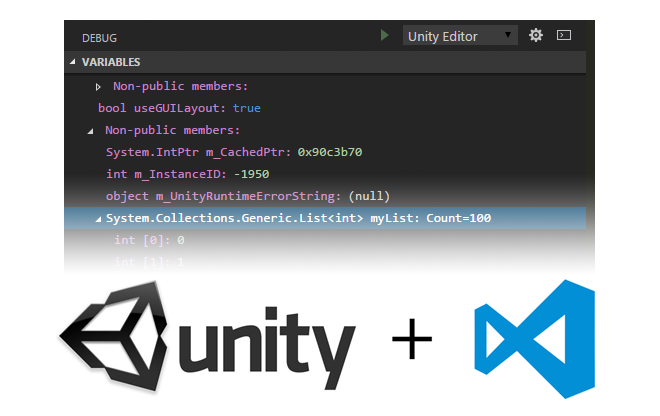

- VISUAL STUDIO CODE UNITY DEBUGGER HOW TO
- VISUAL STUDIO CODE UNITY DEBUGGER FOR MAC
- VISUAL STUDIO CODE UNITY DEBUGGER INSTALL
- VISUAL STUDIO CODE UNITY DEBUGGER SOFTWARE
Primarily we need to add the VSC Debugger for Unity

, support for Unity requires a selection of extensions to be installed (including C# language support). According to Microsoft Documentation -Unity Development with VS Code , support for Unity is included out of the box, which is convenient. As clarified in Jetbrains Documentation - Getting Started with Rider and Unity
VISUAL STUDIO CODE UNITY DEBUGGER FOR MAC
According to Microsoft Documentation - Visual Studio for Mac Tools for Unity, support for Unity is included out of the box.
VISUAL STUDIO CODE UNITY DEBUGGER INSTALL
Search for and install the “Visual Studio 2019 Tools For Unity” (at time of writing) extension. Click “Extensions” → “Manage Extensions” → “Online”. To attach a debugger to Unity, we may need to install extensions to our IDE of choice: We can learn more at Unity Docs : Unity Remote 5. Similarly, this also allows the hardware inputs, on the device, to be used remotely (touch, tilt, cameras etc). Instead of the lengthy process of deploying a project to a device, it can instead be run on the host computer and the graphics streamed as a live video to the App. This is a solution for testing projects targeted at mobile devices and uses a companion app published by Unity. Something worth mentioning is Unity Remote. Getting our project deployed and accessible for debugging on a mobile device requires us to go through a number of additional steps, which we’ll look at later in this article. However, for certain applications - notably with Augmented Reality apps with their reliance on hardware sensors - we have no choice but to deploy and test our application directly on a mobile device. OurCubeObject = GameObject.Find("/Cube") Ī majority of the time, we can run our projects locally using the Unity Editor directly.Īttaching a debugger, running in an IDE such as Visual Studio, is almost identical to the debugging experience that we are probably already familiar with. To demonstrate this in action, add the following code to our demo project to artificially provoke a an error: This feature is unrelated to the presence of a code editor and/or attached debugger. To clarify, exceptions will always show in the Unity Editor console window … but by enabling this toggle, we can stop the game from running, the moment a problem shows up.This is particularly useful if a problem is situation-specific and only appears after some time, etc. This simply pauses the code when an Exception is thrown. It’s therefore useful to know that in the Unity Editor console, there is a toggle button “Error Pause”.
This can make design-time debugging more difficult. In Part 2 - Scripting, we talked about how Unity doesn’t stop when an exception is thrown. Working with exceptions - Unity Editor error pause We’ll be re-using the “BasicPhoneApp” project that we created in the previous article, so if you haven’t already been following along, you should refer back to Part 3 - A prototype mobile app
VISUAL STUDIO CODE UNITY DEBUGGER SOFTWARE
You’ll probably be the sort of person who already has a good feel for how software is created, but just wants an overview of the main features and semantics of how a Unity project hangs-together. Instead, this is meant to be a birds-eye overview, orientated towards existing business developers.
VISUAL STUDIO CODE UNITY DEBUGGER HOW TO
In this article, we’ll be looking at how Unity handles exceptions, how to use the Unity debugger and finally how to make use of logging on an Android device.Īs a reminder, this series is not intended to be an in-depth beginner guide to Unity. The need to see what our code is doing is a fundamental requirement for any developer and using a debugger is usually a primary tool during project development. , we finish the project started in Part 6, by writing a script to call a REST service and populate items in our UI. In Part 7 - Unity UI Scrolling List - Adding the Code , we take on a slightly more complex project, by creating a scrolling list of items using Unity UI. In Part 6 - Unity UI Scrolling List - Creating the Scene , we take a first look at Unity UI and interact with a basic button control. , we look at how we can attach the debugger and use logging - basic tools for any developer. In Part 4 -Logging and debugging with Android In Part 3 - A prototype mobile app, we work through the steps needed to make a super-simple application and deploy it to a mobile device. In Part 2 - Scripting, we learn about some coding concepts that are applicable to Unity. In Part 1 - Getting started, we explore how a business developer could make a start using Unity, look at the Editor and overview some of the common words that you’ll encounter.

NET business developers, who are interested in dipping a toe into something different. This is part four of a beginner-level series about Unity, aimed at existing.


 0 kommentar(er)
0 kommentar(er)
